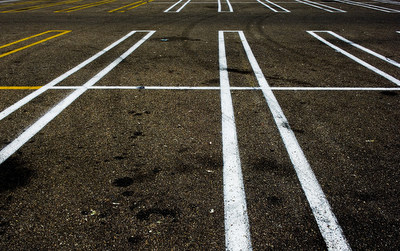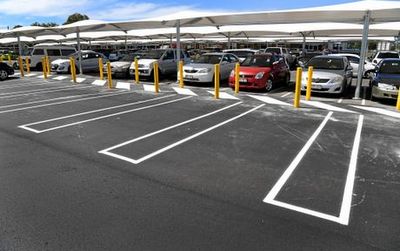
Car park design made the news when NewsMail reported about a shopping centre using double lines to mark bays. While some drivers criticised the design, the car park owner seems supportive of its benefits in comparison to the traditional single line marking.
According to Australian standard, the size of bays with double line marking must be measured from the centre of the pair of marked lines. Although the total space, including the area inside the double lines, remains the same as in traditional car parks, the actual bay is effectively smaller.

The ptc. team identified a number of pros and cons of using double line marking on car park design:
Pros
- Facilitating pedestrian movement between cars
- Possible reduction of cars scratching doors against other vehicles
- Helps drivers to park straight in the centre of the car space
Cons
- The design makes drivers perceive that the bays are smaller than they actually are, potentially generating a negative impression
- More lines can distract drivers making it difficult to identify bays when several spaces in a row are empty
- For most people, it is counterintuitive to park with the tyres on top of the lines which can make the parking experience difficult for large vehicles
- Requires extra turns and manoeuvring to park in the right position
- Higher cost to paint (and maintain) extra lines, compared to traditional design
The key question is should you consider or not this design on your next car park?
As each car park is unique, there isn’t a definitive answer and evaluating the pros and cons of the specific design challenges of your site may indicate the best way. In addition, you need to consider that most drivers are not used to this type of design, and therefore it may take some time for customers to adapt to it.
What is your opinion?
Photo Credit: Radcliffe Dacanay and NewsMail

2 Responses
As a driver, I love the double lines. Just makes it easier to maneuver when you get out of your car!
Double lines are great when there is all day employee parking or little turnover in the lot or structure. It helps keep vehicles straight. However in older structures with an 8.5 foot stall width, today’s larger SUVs and trucks will easily pinch the available space between vehicles. If stall widths are not wide enough, I offer up a customer satisfaction solution. Restripe stalls to a wider width in less used parking areas and redirect the larger vehicles to those areas, thus baiting them with a larger space, and less door dings. We have successfully done that here at ASU in one of our parking structures. We sacrificed spaces on the third floor and put in wider spaces to entice large SUVs and trucks to not park on the higher demand first and second level.